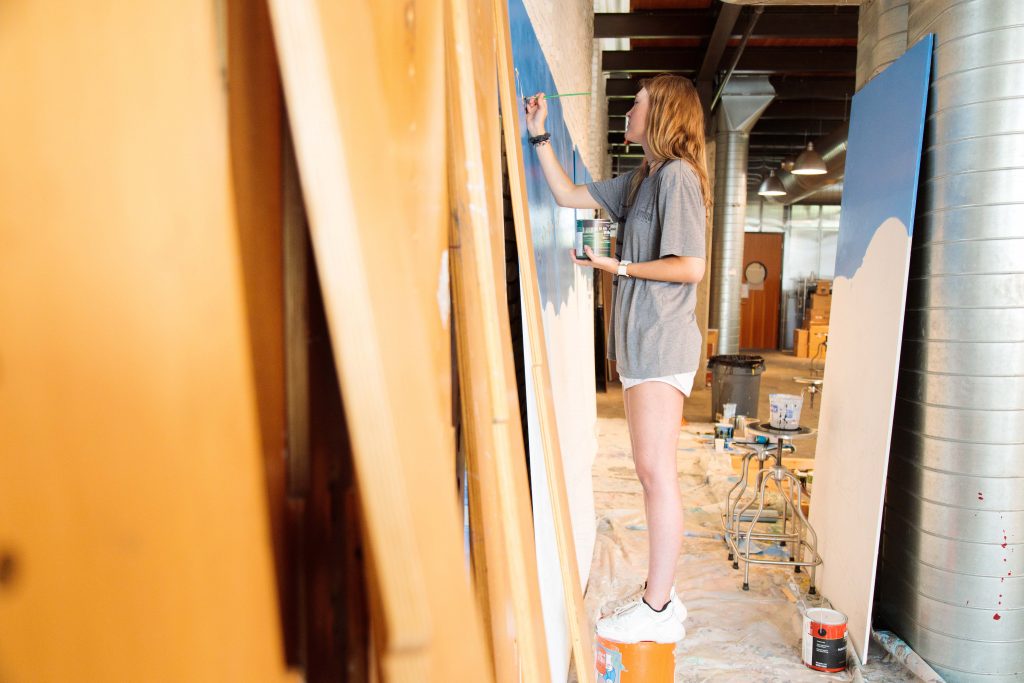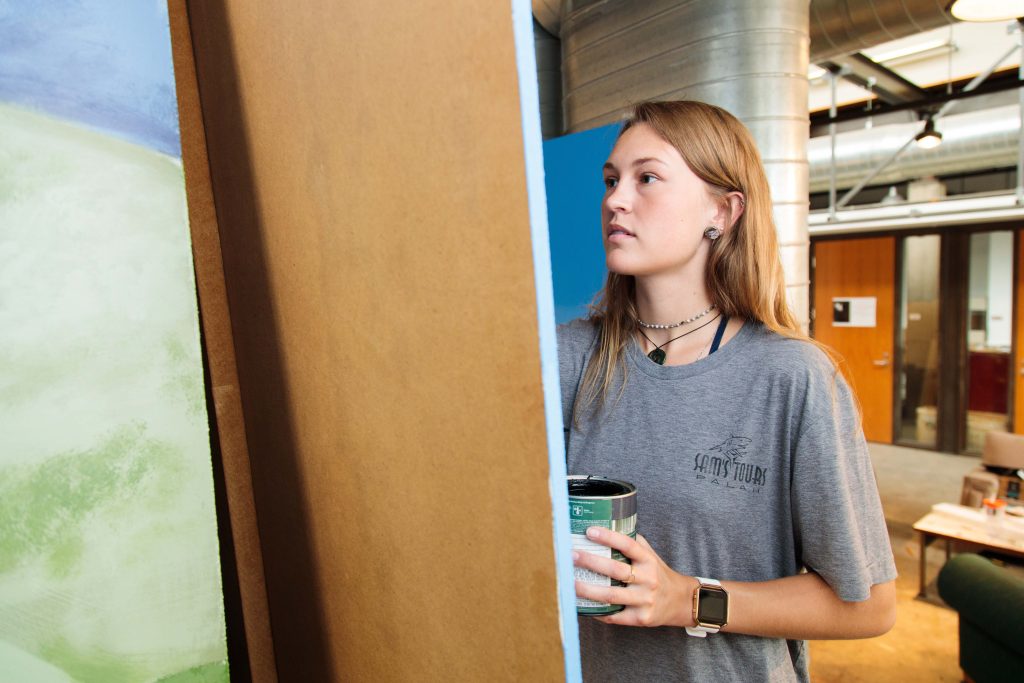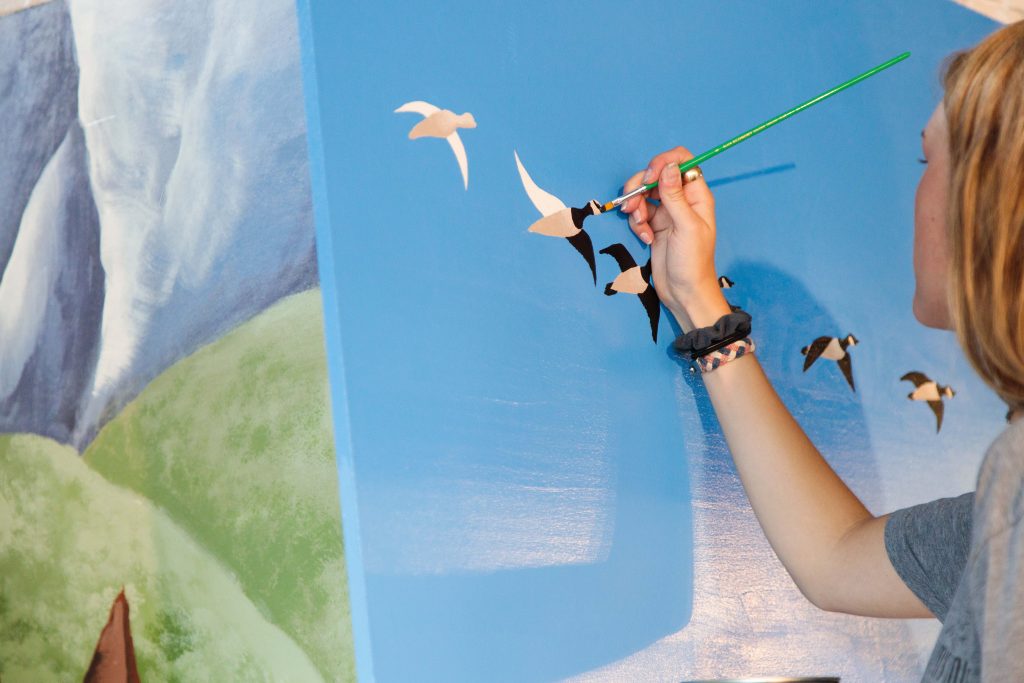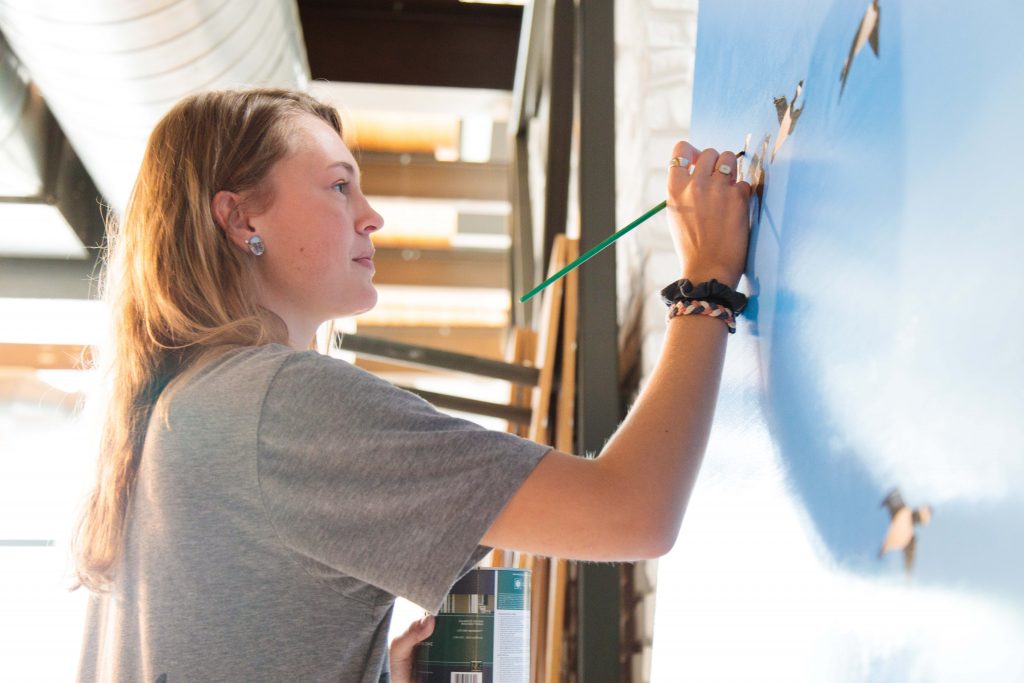By Stephen Wilson
Regan Kinney ’20 stands on top of an overturned bucket so she can reach the top of her canvas—an exterior fiberboard panel 8 feet tall and 70 pounds. Not the typical medium for an artist.
But this is not the typical art project.
 Kinney is painting six panels to hang along the Delaware & Lehigh National Heritage Corridor, a 165-mile multi-use trail that spans from Wilkes-Barre to Philadelphia. The stretch in Easton, which gives the trail its name, is at the convergence of rivers at the Forks of the Delaware.
Kinney is painting six panels to hang along the Delaware & Lehigh National Heritage Corridor, a 165-mile multi-use trail that spans from Wilkes-Barre to Philadelphia. The stretch in Easton, which gives the trail its name, is at the convergence of rivers at the Forks of the Delaware.
The project also sits at a convergence of vision and planning, art and industry, civic and social, and town and gown.
It began with a yearlong Tech Clinic Project where students worked with the D&L Trail and St. Luke’s Hospital to inspire more use of the trail through the health network’s Get Your Tail on the Trail program.
Tech Clinic is a two-semester course in which an interdisciplinary team of six students work together with two professors on imaginative solutions to real-world problems for clients.
Solutions for the D&L Trail spanned several categories: technological, historical, and social. The team created an app to track hiking, running, and biking workouts, planned a five-year anniversary party for the Tail on the Trail program, collaborated with the Humane Society to promote a new trail-side dog park, developed a new signage plan based on the trail’s history, and proposed a mural to cover the graffiti-plagued bridge abutments.
Although that last idea may sound simple, putting something impactful over the spray paint is anything but.
 Kinney has been working on the plans for over a year with her advisers Ed Kerns, Eugene H. Clapp II ’36 Professor of Art, and Lawrence Malinconico, associate professor of geology and director of Technology Clinic.
Kinney has been working on the plans for over a year with her advisers Ed Kerns, Eugene H. Clapp II ’36 Professor of Art, and Lawrence Malinconico, associate professor of geology and director of Technology Clinic.
“It’s been a huge project,” she says. “Lots of preparation and organization, and my advisers have been great supporters and collaborators.”
She drew an original sketch and then made one in color. It then had to be approved by Easton City Council, which meant a presentation at a public meeting … and then, of course, necessary revisions. Once the drawing was approved, she moved to materials.
Kinney worked with her advisers and Dave Hopkins, director of public works for the city, to find a material that would offer the highest quality for a brutal outdoor environment—cold-weather cracking, heat-induced fading, and tag-making vandals. Traditional acrylic paint wouldn’t work either.
“I’m using house paint,” she says. “An exterior semi-gloss is good for weather, but it is not the best for mixing.”
She has had to plan her colors carefully and find inventive ways to blend them and then see how they change under the anti-graffiti coating used to seal the art from would-be graffiti artists.
Finally, the panels—8 feet by 4 feet, six of them. She painted a test panel to see how it would work and feel under her brush.
While the process has been less than ideal, her work is idealistic, not abstract or interpretive.
On the upside-down bucket, Kinney is painting a flock of geese, easy strokes of black to pattern their heads and necks. Behind her, the studio, quiet in summer, vibrates from the HVAC.
 “I get so focused when I am painting that I can forget to eat and drink,” she says. “I stop thinking and just escape into the work. It is very therapeutic.”
“I get so focused when I am painting that I can forget to eat and drink,” she says. “I stop thinking and just escape into the work. It is very therapeutic.”
She describes her style as “realistic.” The scene, spreading across the panels, is an idyllic moment from olde Easton: the canal, a donkey-pulled barge, farm, lumberyard, rolling hills, steel bridge, blast furnace, and railroad.
“It is an idealistic snapshot,” she says. “Something to add color to the trail and connect people to the history of the canal and trail.
“It is a surreal thought to think that I will leave this work behind for so many people to see and, hopefully, bring happiness to,” she says. “Easton is an amazing place, and Lafayette has provided me so many opportunities; this is my opportunity to give back. A project like this, I couldn’t resist.”

 Kinney is painting six panels to hang along the
Kinney is painting six panels to hang along the  Kinney has been working on the plans for over a year with her advisers
Kinney has been working on the plans for over a year with her advisers  “I get so focused when I am painting that I can forget to eat and drink,” she says. “I stop thinking and just escape into the work. It is very therapeutic.”
“I get so focused when I am painting that I can forget to eat and drink,” she says. “I stop thinking and just escape into the work. It is very therapeutic.”